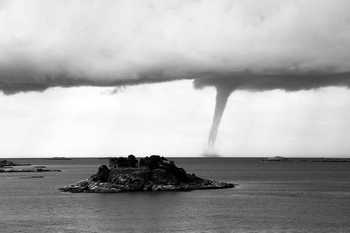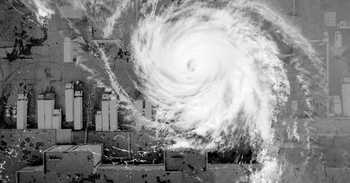Hurricane season has become more destructive in the 21st century. Development in coastal areas, as well as more volatile annual storm seasons, has produced immense vulnerability for populations who live and work on the Atlantic and Gulf coasts. According to a 2019 Census estimate, 60.2 million Americans live in areas vulnerable to hurricane destruction. Hurricanes affect both the physical landscape and social fabric, leaving a wake of severely damaged infrastructure and disrupting essential services.
About 75% of disaster-related costs came from billion-dollar disasters from 1980-2000, but in recent years, large losses from hurricanes and wildfires have affected this distribution. By 2010, about 80% of disaster-related costs were associated with billion-dollar events. By 2021, it had increased to 85%. Development in vulnerable areas, like coasts and wildland-urban interfaces, has been a strong driver of these changes.
60.2 million Americans live in areas vulnerable to hurricane destruction.
The rising cost of hurricane damage
At the turn of the century, the number of billion-dollar disasters has increased. While the 1980s averaged 2.9 billion-dollar disasters a year, and the 1990s averaged 5.3, the 2010s averaged 12.3 individual billion-dollar disasters a year. The incidence of high-profile hurricanes, producing many billions of dollars of losses has also increased. Figure 1 shows the incidence of billion-dollar hurricanes affecting America, with labeled storms causing over $50 billion in losses.

Of the 363-billion-dollar weather disasters since 1980, hurricanes and tropical cyclones have caused the most damage, costing over 1.3 trillion total, an average of 22.8 billion dollars per event. Fifty-six individual weather and climate disasters from 2019 to 2020 produced losses in excess of $1 billion.
In 2021, 20 separate billion-dollar weather and climate disasters totaled $145 billion in losses. The highest costs ever accrued in 2017 at $306.2 billion. Figure 2 shows the decade totals for hurricane costs.

Hurricane frequency also increasing
Alarmingly, in addition to the rising cost of hurricane damage, the count of hurricanes has also increased.
In 2017, Hurricane Irma skirted Puerto Rico's northern coast, debilitating the infrastructure with heavy rains, flooding, and dangerously high winds. Roughly two-thirds of the population were already without electricity when Hurricane Maria struck two weeks later, causing even worse devastation.
In addition to the rising cost of hurricane damage, the count of hurricanes has also increased.
While hurricane season risk is traditionally associated with the Atlantic and Gulf coasts, August 2023 saw Tropical Storm Hillary break rainfall records in southern California, as the first tropical storm to reach Southern California in 84 years. Figure 3 shows that the current decade has already outpaced the hurricane count of the 2010s, reflecting an increased risk of costly storms, and compounding disasters, in the coming hurricane seasons.

Tropical cyclones are responsible for more deaths than any other type of disaster event, an estimated 6,890 since 1980. Tropical cyclones can have long-standing implications for public health — these outcomes are largely dependent on the severity of the storm and community resilience. Areas affected by tropical cyclones include some of the wealthiest and poorest communities in the United States. The methodology for attributing deaths to tropical cyclones is inconsistent and can vary greatly. For instance, Hurricane Maria’s official death counts were as much as 70 times lower than local recorded excess mortality.
Swift response and on-the-ground operations in Hurricane Maria aftermath
In 2017, in the immediate wake of Hurricane Maria, Pinkerton was the only security organization to establish on-the-ground operations in the first week following Maria, establishing a base of operations and flying in cargo planes with additional agents and fundamental supplies. Pinkerton agents even assisted other security organizations in facilitating travel and evacuation for their clients.
Additionally, Pinkerton agents coordinated ad hoc search and rescue missions, locating nearly 900 missing employees, supplying them with fresh water and food, and relocating some 200 to more secure locations. Pinkerton also reestablished the fundamental security of client facilities.
Pinkerton’s interventions made a meaningful difference in the effective duty of care offered by their base of clients working in Puerto Rico in the first month of recovery from this record-setting disaster. While hurricanes cannot be prevented, proper preparation can mitigate damage, loss of life, and harm to assets.
Pinkerton Risk Pulse: Advanced site-specific risk assessment at your fingertips
While hurricanes cannot be prevented, proper preparation can mitigate damage, loss of life, and harm to assets – and this includes understanding the risk at your locations.
Pinkerton Risk Pulse uses authoritative information from FEMA to assess how often — and how fiercely — hurricanes and 13 additional natural disasters could impact the neighborhoods where your organizations are located. A neighborhood's hazard index score is our key figure, detailing the estimated annual risk to buildings, crops, and even people, in simple terms. However, we don’t just count the events, we calculate the potential dollar damage to the local economy.
And should organizations require it, Pinkerton’s risk consulting and response services can help them with crisis management planning before and strong business continuity after.
Pinkerton. We Never Sleep.
Sources:
Cohen, Daryl. “About 60.2M Live in Areas Most Vulnerable to Hurricanes.” Census.gov, 7 July 2019. https://www.census.gov/library/stories/2019/07/millions-of-americans-live-coastline-regions.html#:~:text=About%2060.2M%20Live%20in%20Areas%20Most%20Vulnerable%20to%20Hurricanes&text=About%2094.7%20million%20people%2C%20or,a%2015.3%25%20growth%20since%202000
NOAA National Centers for Environmental Information (NCEI) U.S. Billion-Dollar Weather and Climate Disasters (2023).
https://www.ncei.noaa.gov/access/billions/, DOI: 10.25921/stkw-7w73
Office for Coastal Management. “Hurricane Costs.” Coast.noaa.gov.
https://coast.noaa.gov/states/fast-facts/hurricane-costs.html#:~:text=2021%3A%20Year%20in%20Review&text=The%20total%20cost%20for%20the,nearly%20%24148.4%20billion%20per%20year
Smith, Adam B. “2021 U.S. billion-dollar weather and climate disasters in historical context.” Climate.gov, 24 January 2022.
https://www.climate.gov/news-features/blogs/beyond-data/2021-us-billion-dollar-weather-and-climate-disasters-historical





